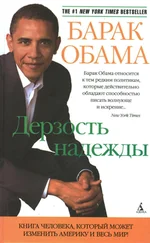Барак Обама - The Audacity of Hope
Здесь есть возможность читать онлайн «Барак Обама - The Audacity of Hope» весь текст электронной книги совершенно бесплатно (целиком полную версию без сокращений). В некоторых случаях можно слушать аудио, скачать через торрент в формате fb2 и присутствует краткое содержание. Жанр: Политика, на английском языке. Описание произведения, (предисловие) а так же отзывы посетителей доступны на портале библиотеки ЛибКат.
- Название:The Audacity of Hope
- Автор:
- Жанр:
- Год:неизвестен
- ISBN:нет данных
- Рейтинг книги:5 / 5. Голосов: 1
-
Избранное:Добавить в избранное
- Отзывы:
-
Ваша оценка:
- 100
- 1
- 2
- 3
- 4
- 5
The Audacity of Hope: краткое содержание, описание и аннотация
Предлагаем к чтению аннотацию, описание, краткое содержание или предисловие (зависит от того, что написал сам автор книги «The Audacity of Hope»). Если вы не нашли необходимую информацию о книге — напишите в комментариях, мы постараемся отыскать её.
The Audacity of Hope — читать онлайн бесплатно полную книгу (весь текст) целиком
Ниже представлен текст книги, разбитый по страницам. Система сохранения места последней прочитанной страницы, позволяет с удобством читать онлайн бесплатно книгу «The Audacity of Hope», без необходимости каждый раз заново искать на чём Вы остановились. Поставьте закладку, и сможете в любой момент перейти на страницу, на которой закончили чтение.
Интервал:
Закладка:
Aside from making needed investments that private enterprise can’t or won’t make on its own, an active national government has also been indispensable in dealing with market failures — those recurring snags in any capitalist system that either inhibit the efficient workings of the market or result in harm to the public. Teddy Roosevelt recognized that monopoly power could restrict competition, and made “trust busting” a centerpiece of his administration. Woodrow Wilson instituted the Federal Reserve Bank, to manage the money supply and curb periodic panics in the financial markets. Federal and state governments established the first consumer laws — the Pure Food and Drug Act, the Meat Inspection Act — to protect Americans from harmful products.
But it was during the stock market crash of 1929 and the subsequent Depression that the government’s vital role in regulating the marketplace became fully apparent. With investor confidence shattered, bank runs threatening the collapse of the financial system, and a downward spiral in consumer demand and business investment, FDR engineered a series of government interventions that arrested further economic contraction. For the next eight years, the New Deal administration experimented with policies to restart the economy, and although not all of these interventions produced their intended results, they did leave behind a regulatory structure that helps limit the risk of economic crisis: a Securities and Exchange Commission to ensure transparency in the financial markets and protect smaller investors from fraud and insider manipulation; FDIC insurance to provide confidence to bank depositors; and countercyclical fiscal and monetary policies, whether in the form of tax cuts, increased liquidity, or direct government spending, to stimulate demand when business and consumers have pulled back from the market.
Finally — and most controversially — government has helped structure the social compact between business and the American worker. During America’s first 150 years, as capital became more concentrated in trusts and limited liability corporations, workers were prevented by law and by violence from forming unions that would increase their own leverage. Workers had almost no protections from unsafe or inhumane working conditions, whether in sweatshops or meatpacking plants. Nor did American culture have much sympathy for workers left impoverished by capitalism’s periodic gales of “creative destruction”—the recipe for individual success was greater toil, not pampering from the state. What safety net did exist came from the uneven and meager resources of private charity.
Again, it took the shock of the Great Depression, with a third of all people finding themselves out of work, ill housed, ill clothed, and ill fed, for government to correct this imbalance. Two years into office, FDR was able to push through Congress the Social Security Act of 1935, the centerpiece of the new welfare state, a safety net that would lift almost half of all senior citizens out of poverty, provide unemployment insurance for those who had lost their jobs, and provide modest welfare payments to the disabled and the elderly poor. FDR also initiated laws that fundamentally changed the relationship between capital and labor: the forty-hour workweek, child labor laws, and minimum wage laws; and the National Labor Relations Act, which made it possible to organize broad-based industrial unions and forced employers to bargain in good faith.
Part of FDR’s rationale in passing these laws came straight out of Keynesian economics: One cure for economic depression was putting more disposable income in the pockets of American workers. But FDR also understood that capitalism in a democracy required the consent of the people, and that by giving workers a larger share of the economic pie, his reforms would undercut the potential appeal of government-managed, command-and-control systems — whether fascist, socialist, or communist — that were gaining support all across Europe. As he would explain in 1944, “People who are hungry, people who are out of a job are the stuff of which dictatorships are made.”
For a while this seemed to be where the story would end — with FDR saving capitalism from itself through an activist federal government that invests in its people and infrastructure, regulates the marketplace, and protects labor from chronic deprivation. And in fact, for the next twenty-five years, through Republican and Democratic administrations, this model of the American welfare state enjoyed a broad consensus. There were those on the right who complained of creeping socialism, and those on the left who believed FDR had not gone far enough. But the enormous growth of America’s mass production economy, and the enormous gap in productive capacity between the United States and the war-torn economies of Europe and Asia, muted most ideological battles. Without any serious rivals, U.S. companies could routinely pass on higher labor and regulatory costs to their customers. Full employment allowed unionized factory workers to move into the middle class, support a family on a single income, and enjoy the stability of health and retirement security. And in such an environment of steady corporate profits and rising wages, policy makers found only modest political resistance to higher taxes and more regulation to tackle pressing social problems — hence the creation of the Great Society programs, including Medicare, Medicaid, and welfare, under Johnson; and the creation of the Environmental Protection Agency and Occupational Health and Safety Administration under Nixon.
There was only one problem with this liberal triumph — capitalism would not stand still. By the seventies, U.S. productivity growth, the engine of the postwar economy, began to lag. The increased assertiveness of OPEC allowed foreign oil producers to lop off a much bigger share of the global economy, exposing America’s vulnerability to disruptions in energy supplies. U.S. companies began to experience competition from low-cost producers in Asia, and by the eighties a flood of cheap imports — in textiles, shoes, electronics, and even automobiles — had started grabbing big chunks of the domestic market. Meanwhile, U.S.-based multinational corporations began locating some of their production facilities overseas — partly to access these foreign markets, but also to take advantage of cheap labor.
In this more competitive global environment, the old corporate formula of steady profits and stodgy management no longer worked. With less ability to pass on higher costs or shoddy products to consumers, corporate profits and market share shrank, and corporate shareholders began demanding more value. Some corporations found ways to improve productivity through innovation and automation. Others relied primarily on brutal layoffs, resistance to unionization, and a further shift of production overseas. Those corporate managers who didn’t adapt were vulnerable to corporate raiders and leveraged buyout artists, who would make the changes for them, without any regard for the employees whose lives might be upended or the communities that might be torn apart. One way or another, American companies became leaner and meaner — with old-line manufacturing workers and towns like Galesburg bearing the brunt of this transformation.
It wasn’t just the private sector that had to adapt to this new environment. As Ronald Reagan’s election made clear, the people wanted the government to change as well.
In his rhetoric, Reagan tended to exaggerate the degree to which the welfare state had grown over the previous twenty-five years. At its peak, the federal budget as a total share of the U.S. economy remained far below the comparable figures in Western Europe, even when you factored in the enormous U.S. defense budget. Still, the conservative revolution that Reagan helped usher in gained traction because Reagan’s central insight — that the liberal welfare state had grown complacent and overly bureaucratic, with Democratic policy makers more obsessed with slicing the economic pie than with growing the pie — contained a good deal of truth. Just as too many corporate managers, shielded from competition, had stopped delivering value, too many government bureaucracies had stopped asking whether their shareholders (the American taxpayer) and their consumers (the users of government services) were getting their money’s worth.
Читать дальшеИнтервал:
Закладка:
Похожие книги на «The Audacity of Hope»
Представляем Вашему вниманию похожие книги на «The Audacity of Hope» списком для выбора. Мы отобрали схожую по названию и смыслу литературу в надежде предоставить читателям больше вариантов отыскать новые, интересные, ещё непрочитанные произведения.
Обсуждение, отзывы о книге «The Audacity of Hope» и просто собственные мнения читателей. Оставьте ваши комментарии, напишите, что Вы думаете о произведении, его смысле или главных героях. Укажите что конкретно понравилось, а что нет, и почему Вы так считаете.

![Барак Обама - Дерзость надежды. Мысли об возрождении американской мечты [The Audacity of Hope]](/books/26630/barak-obama-derzost-nadezhdy-mysli-ob-vozrozhdenii-thumb.webp)










